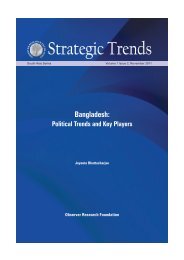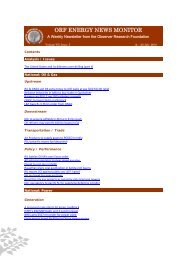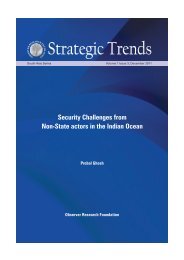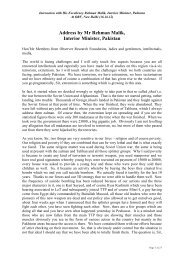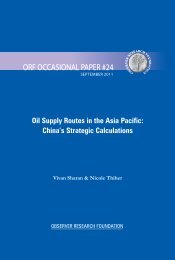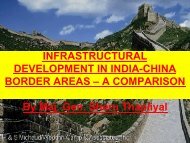Produced and Published by Observer Research Foundation 1 Vol. II ...
Produced and Published by Observer Research Foundation 1 Vol. II ...
Produced and Published by Observer Research Foundation 1 Vol. II ...
You also want an ePaper? Increase the reach of your titles
YUMPU automatically turns print PDFs into web optimized ePapers that Google loves.
the Senkakus, five other ships —<br />
the Haijian 50, 15, 49, 66 <strong>and</strong> 137<br />
— were ordered to alter course <strong>and</strong><br />
converge on the area. Running in<br />
four formations, the eight Chinese<br />
ships monitored the Japanese ships<br />
from different angles, it said in a<br />
statement. Prime Minister Shinzo<br />
Abe vowed to “expel <strong>by</strong> force” any<br />
Chinese l<strong>and</strong>ing on the islets. “We<br />
would take decisive action against<br />
any attempt to enter territorial<br />
waters <strong>and</strong> to l<strong>and</strong>,” Abe told the<br />
Diet in response to questions from<br />
lawmakers. “We would never<br />
allow” a l<strong>and</strong>ing. “It would be<br />
natural for us to expel <strong>by</strong> force (the<br />
Chinese) if they were to make a<br />
l<strong>and</strong>ing,” he said. According to the<br />
11th Regional Coast Guard<br />
Headquarters, Japan’s surveillance<br />
vessels instructed the Chinese ships<br />
to leave after they entered the area<br />
in succession between 7:20 a.m.<br />
<strong>and</strong> 8:25 a.m. Two Chinese fishery<br />
surveillance vessels were also<br />
spotted sailing in the contiguous<br />
zone outside the territorial waters<br />
around the islets, the coast guard<br />
said. Suga said he was not in a<br />
position to know China’s intent but<br />
added he did not believe the ships’<br />
activity had anything to do with<br />
recent visits to war-linked Yasukuni<br />
Shrine in Tokyo <strong>by</strong> some Cabinet<br />
members. Bilateral relations have<br />
been frayed over conflicting claims<br />
to the islets as well as visits to<br />
Yasukuni, which honors 2.5 million<br />
Japanese war dead, including 14<br />
Class-A war criminals.<br />
Source: The Japan Times, 24 April<br />
2013<br />
Chinese navy patrols Diaoyu<br />
Isl<strong>and</strong>s on treaty anniversary<br />
A Chinese naval fleet patrolled the<br />
waters surrounding the Diaoyu<br />
Isl<strong>and</strong>s on 17 April, the anniversary<br />
of the signing of an unequal treaty<br />
between China <strong>and</strong> Japan in 1895.<br />
Composed of two warships, the<br />
Lanzhou missile destroyer <strong>and</strong> the<br />
Hengshui missile frigate, the<br />
Chinese People's Liberation Army<br />
Navy fleet crossed the Mayako<br />
Strait on 16 th night <strong>and</strong> arrived at<br />
the waters surrounding the Diaoyu<br />
Isl<strong>and</strong>s early 17 th morning. The<br />
fleet finished a series of attack <strong>and</strong><br />
defense drills in the west Pacific<br />
area after it sailed out from port.<br />
Zhao Xiaogang, the comm<strong>and</strong>er of<br />
the fleet, which belongs to the<br />
Nanhai Fleet, told a Xinhua<br />
correspondent aboard the Lanzhou<br />
destroyer that the navy's patrol<br />
around the Diaoyu Isl<strong>and</strong>s is<br />
legitimate <strong>and</strong> undisputable, as the<br />
isl<strong>and</strong>s are China's indispensable<br />
territory. The PLA navy patrolled<br />
on the day of historical<br />
significance, as the Treaty of<br />
Shimonoseki between the two<br />
countries was signed on April 17,<br />
1895, following China's defeat in<br />
the first Sino-Japanese War (1894 -<br />
1895). According to the treaty,<br />
China ceded Taiwan <strong>and</strong> its<br />
affiliated isl<strong>and</strong>s to Japan, <strong>and</strong> paid<br />
Japan as a war indemnity the sum<br />
of 200 million Kupingtaels. The<br />
treaty was reversed after Japan's<br />
defeat in World War <strong>II</strong>. Tensions<br />
were raised between the two<br />
neighboring countries over the<br />
isl<strong>and</strong>s after Japan's so-called<br />
"nationalization" of Diaoyu Isl<strong>and</strong><br />
<strong>and</strong> part of its affiliated islets last<br />
year, as well as Japanese politicians'<br />
aggressive remarks over Japan-<br />
China ties.<br />
Source: Xinhua, 18 April 2013<br />
China accuses Japan of ‘making<br />
trouble’ over Senkaku Isl<strong>and</strong>s<br />
China accused Japan on 16 April of<br />
“making trouble” <strong>by</strong> nationalizing<br />
the Senkaku Isl<strong>and</strong>s. “On the issues<br />
concerning China’s territorial<br />
sovereignty <strong>and</strong> maritime rights <strong>and</strong><br />
interests, some neighbouring<br />
countries are taking actions that<br />
complicate or exacerbate the<br />
situation, <strong>and</strong> Japan is making<br />
trouble over the issue of the<br />
Diaoyu Isl<strong>and</strong>s,” the Chinese<br />
government said in a defense white<br />
paper, the first such report issued<br />
in two years. Diaoyu is the Chinese<br />
name for the disputed <strong>and</strong><br />
uninhabited islets in the East China<br />
Sea. The Japanese government<br />
responded immediately <strong>by</strong><br />
protesting the report through<br />
diplomatic channels, repeating that<br />
there is no territorial dispute<br />
between the two countries because<br />
the islets are Japanese territory.<br />
Bilateral relations have deteriorated<br />
since the central government<br />
purchased some of the islets from a<br />
Saitama businessman last<br />
September. Citing a military-civilian<br />
drill in the East China Sea last<br />
October, the paper says the<br />
People’s Liberation Army Navy has<br />
enhanced capabilities in partnership<br />
with marine surveillance <strong>and</strong><br />
fishery administration departments<br />
to coordinate comm<strong>and</strong> <strong>and</strong><br />
respond to emergencies in joint<br />
military-civilian operations to<br />
safeguard maritime rights. Titled<br />
“The Diversified Employment of<br />
China’s Armed Forces,” the paper<br />
says the Asia-Pacific region has<br />
become an increasingly significant<br />
stage for world economic<br />
<strong>Produced</strong> <strong>and</strong> <strong>Published</strong> <strong>by</strong> <strong>Observer</strong> <strong>Research</strong> <strong>Foundation</strong><br />
5




